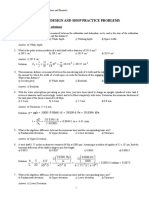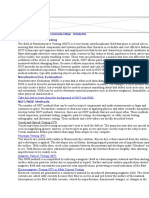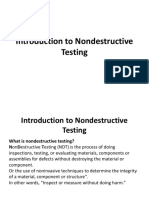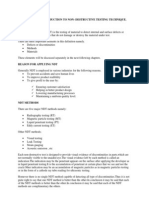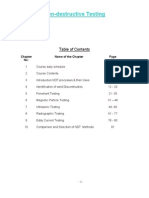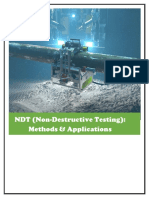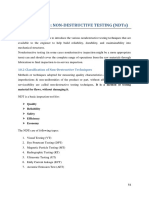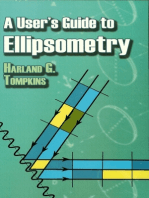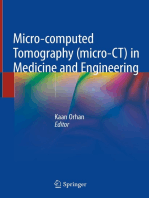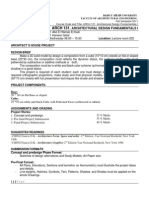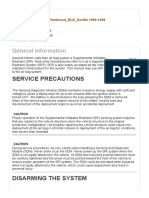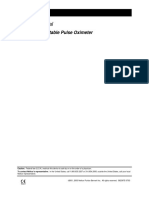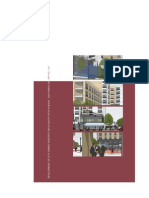Intro For NDT and NDE
Intro For NDT and NDE
Uploaded by
konainglincho001Copyright:
Available Formats
Intro For NDT and NDE
Intro For NDT and NDE
Uploaded by
konainglincho001Original Title
Copyright
Available Formats
Share this document
Did you find this document useful?
Is this content inappropriate?
Copyright:
Available Formats
Intro For NDT and NDE
Intro For NDT and NDE
Uploaded by
konainglincho001Copyright:
Available Formats
About NDT
Page 1 of 3
Home - About NDT
What is NDT?
The field of Nondestructive Testing (NDT) is a very broad, interdisciplinary field that plays a critical role in assuring that structural components and systems perform their function in a reliable and cost effective fashion. NDT technicians and engineers define and implement tests that locate and characterize material conditions and flaws that might otherwise cause planes to crash, reactors to fail, trains to derail, pipelines to burst, and a variety of less visible, but equally troubling events. These tests are performed in a manner that does not affect the future usefulness of the object or material. In other words, NDT allows parts and material to be inspected and measured without damaging them. Because it allows inspection without interfering with a product's final use, NDT provides an excellent balance between quality control and cost-effectiveness. Generally speaking, NDT applies to industrial inspections. Technology that is used in NDT is similar to those used in the medical industry; yet, typically nonliving objects are the subjects of the inspections. What is NDE? Nondestructive evaluation (NDE) is a term that is often used interchangeably with NDT. However, technically, NDE is used to describe measurements that are more quantitative in nature. For example, an NDE method would not only locate a defect, but it would also be used to measure something about that defect such as its size, shape, and orientation. NDE may be used to determine material properties, such as fracture toughness, formability, and other physical characteristics. Some NDT/NDE Technologies: Many people are already familiar with some of the technologies that are used in NDT and NDE from their uses in the medical industry. Most people have also had an X-ray taken and many mothers have had ultrasound used by doctors to give their baby a checkup while still in the womb. X-rays and ultrasound are only a few of the technologies used in the field of NDT/NDE. The number of inspection methods seems to grow daily, but a quick summary of the most commonly used methods is provided below. Visual and Optical Testing (VT) The most basic NDT method is visual examination. Visual examiners follow procedures that range from simply looking at a part to see if surface imperfections are visible, to using computer controlled camera systems to automatically recognize and measure features of a component. Radiography (RT) NDT in use!
Rail Inspection Aircraft Inspection Liberty Bell Inspection Bridge Inspection Storage Tank Inspection Wire Rope Inspection Pipeline Inspection
http://www.ndt-ed.org/AboutNDT/aboutndt.htm
10/3/2004
About NDT
Page 2 of 3
RT involves the use of penetrating gamma- or X-radiation to examine material's and product's defects and internal features. An X-ray machine or radioactive isotope is used as a source of radiation. Radiation is directed through a part and onto film or other media. The resulting shadowgraph shows the internal features and soundness of the part. Material thickness and density changes are indicated as lighter or darker areas on the film. The darker areas in the radiograph below represent internal voids in the component.
Magnetic Particle Testing (MT) This NDT method is accomplished by inducing a magnetic field in a ferromagnetic material and then dusting the surface with iron particles (either dry or suspended in liquid). Surface and near-surface flaws produce magnetic poles or distort the magnetic field in such a way that the iron particles are attracted and concentrated. This produces a visible indication of defect on the surface of the material. The images below demonstrate a component before and after inspection using dry magnetic particles. Ultrasonic Testing (UT) In ultrasonic testing, high-frequency sound waves are transmitted into a material to detect imperfections or to locate changes in material properties. The most commonly used ultrasonic testing technique is pulse echo, whereby sound is introduced into a test object and reflections (echoes) from internal imperfections or the part's geometrical surfaces are returned to a receiver . Below is an example of shear wave weld inspection. Notice the indication extending to the upper limits of the screen. This indication is produced by sound reflected from a defect within the weld. Penetrant Testing (PT) The test object is coated with a solution that contains a visible or fluorescent dye. Excess solution is then removed from the surface of the object but leaving it in surface breaking defects. A
http://www.ndt-ed.org/AboutNDT/aboutndt.htm
10/3/2004
About NDT
Page 3 of 3
developer is then applied to draw the penetrant out of the defects. With fluorescent dyes, ultraviolet light is used to make the bleedout fluoresce brightly, thus allowing imperfections to be readily seen . With visible dyes, vivid color contrasts between the penetrant and developer make "bleedout" easy to see. The red indications below represent a number of defects in this component. Electromagnetic Testing (ET) Electrical currents (eddy currents) are generated in a conductive material by a changing magnetic field. The strength of these eddy currents can be measured. Material defects cause interruptions in the flow of the eddy currents which alert the inspector to the presence of a defect. Eddy currents are also affected by the electrical conductivity and magnetic permeability of a material, which makes it possible to sort some materials based on these properties. The technician below is inspecting an aircraft wing for defects. Leak Testing (LT) Several techniques are used to detect and locate leaks in pressure containment parts, pressure vessels, and structures. Leaks can be detected by using electronic listening devices, pressure gauge measurements, liquid and gas penetrant techniques, and/or a simple soap-bubble test. Acoustic Emission Testing (AE) When a solid material is stressed, imperfections within the material emit short bursts of acoustic energy called "emissions." As in ultrasonic testing, acoustic emissions can be detected by special receivers. Emission sources can be evaluated through the study of their intensity and arrival time to collect information about the sources of the energy, such as their location. -
http://www.ndt-ed.org/AboutNDT/aboutndt.htm
10/3/2004
You might also like
- The Physics and Technology of Diagnostic Ultrasound: A Practitioner's Guide (Second Edition)From EverandThe Physics and Technology of Diagnostic Ultrasound: A Practitioner's Guide (Second Edition)No ratings yet
- Industrial Applications of Infrared Thermography: How Infrared Analysis Can be Used to Improve Equipment InspectionFrom EverandIndustrial Applications of Infrared Thermography: How Infrared Analysis Can be Used to Improve Equipment InspectionRating: 4.5 out of 5 stars4.5/5 (3)
- BCH Encoder DecoderDocument17 pagesBCH Encoder DecoderGaurav UmarNo ratings yet
- Ibong Tiririt MDSP 1Document28 pagesIbong Tiririt MDSP 1Jun-Jie Vosotros100% (1)
- NDT DataDocument3 pagesNDT Dataduayogesh07No ratings yet
- Nondestructive Testing: Home - Education Resources - Community College - IntroductionDocument2 pagesNondestructive Testing: Home - Education Resources - Community College - IntroductionRakesh SrivastavaNo ratings yet
- Nondestructive Testing: Take This Link To Learn About The Background of NDT and NDEDocument2 pagesNondestructive Testing: Take This Link To Learn About The Background of NDT and NDEأحمد دعبسNo ratings yet
- What Is NDT?: Visual and Optical Testing (VT)Document3 pagesWhat Is NDT?: Visual and Optical Testing (VT)Mario MeloNo ratings yet
- 6 Airframe InspectionDocument6 pages6 Airframe InspectionAmiera NorazmiNo ratings yet
- NDT IntroDocument2 pagesNDT IntrojomsedNo ratings yet
- NDT TestingDocument20 pagesNDT TestingmohanNo ratings yet
- Nondestructive Testing: Take This Link To Learn About The Background of NDT and NDEDocument4 pagesNondestructive Testing: Take This Link To Learn About The Background of NDT and NDEAdrian DavidNo ratings yet
- Metalscan Inspection Services Presents: Nondestructive EvaluationDocument15 pagesMetalscan Inspection Services Presents: Nondestructive Evaluationnaganathan100% (2)
- What Is NDTDocument2 pagesWhat Is NDTSrinivasan KNo ratings yet
- ME Lecture 6 Rev21Document46 pagesME Lecture 6 Rev21hassanzohaib7823No ratings yet
- 1 Introduction To Nondestructive TestingDocument36 pages1 Introduction To Nondestructive TestingPedro AscanioNo ratings yet
- NDT Method & Besic Weld SpecificationsDocument244 pagesNDT Method & Besic Weld SpecificationsEnterprising InnovationsNo ratings yet
- Non-Destructive Methods in AviationDocument6 pagesNon-Destructive Methods in AviationAmeem TariqNo ratings yet
- Introduction To NDTDocument6 pagesIntroduction To NDTCepi Sindang KamulanNo ratings yet
- NDT MethodsDocument2 pagesNDT MethodsAekJayNo ratings yet
- 1 Introduction To Nondestructive TestingDocument26 pages1 Introduction To Nondestructive TestingsivasaNo ratings yet
- 3 JaiDocument15 pages3 Jaijai ramNo ratings yet
- Assigment of NDTDocument3 pagesAssigment of NDTHamid AliNo ratings yet
- What Is NDTDocument3 pagesWhat Is NDTmabppuNo ratings yet
- 1 - NDT Basics Ut, MT.,PT, RiDocument20 pages1 - NDT Basics Ut, MT.,PT, RiGMNo ratings yet
- Soalan ExamDocument4 pagesSoalan ExamCik AmorNo ratings yet
- NDTDocument80 pagesNDTsungkang92% (12)
- NDT (Non-Destructive Testing) : Critical InfrastructureDocument15 pagesNDT (Non-Destructive Testing) : Critical InfrastructureVasyl PanasyukNo ratings yet
- 1 Introduction To Nondestructive TestingDocument24 pages1 Introduction To Nondestructive TestingAmol DeshmukhNo ratings yet
- Nondestructive Testing - WikipediaDocument71 pagesNondestructive Testing - WikipediaEndhy Wisnu Novindra100% (1)
- NDTDocument93 pagesNDTVincent Vijayakumar50% (4)
- Non Destructive Testing::Akash Tripathi Mechanical Engineering (2014-18:D41 (4 Year)Document29 pagesNon Destructive Testing::Akash Tripathi Mechanical Engineering (2014-18:D41 (4 Year)Akash TripathiNo ratings yet
- Bab 2 (NDT)Document17 pagesBab 2 (NDT)Salleh AkhnasNo ratings yet
- Non Destructive TestDocument11 pagesNon Destructive TestSenthil Kumar PNo ratings yet
- NDT (Short Presentation)Document35 pagesNDT (Short Presentation)Ashish Panchal100% (1)
- NDT (Methods & Applications)Document16 pagesNDT (Methods & Applications)Ahmed Adel100% (2)
- Define NDTDocument2 pagesDefine NDTCanh LeNo ratings yet
- Chapter No 10Document7 pagesChapter No 10MuhammadAwaisNo ratings yet
- Morla, Mark Jude M. - ReactionPaper7 - MEC-0325-2 (Lec)Document1 pageMorla, Mark Jude M. - ReactionPaper7 - MEC-0325-2 (Lec)MarkJude MorlaNo ratings yet
- NDT TextDocument5 pagesNDT TextCanh LeNo ratings yet
- Nondestructive Testing - Wikipedia PDFDocument12 pagesNondestructive Testing - Wikipedia PDFVysakh VasudevanNo ratings yet
- Non Destructive TestingDocument54 pagesNon Destructive Testingmahi1437100% (1)
- NDT HistoryDocument4 pagesNDT HistorygriselramoniNo ratings yet
- Unit 5 - 5 & 15 MarksDocument12 pagesUnit 5 - 5 & 15 MarksBipul VermaNo ratings yet
- For students-NDT_Visual ExaminationDocument28 pagesFor students-NDT_Visual Examinationyogeshwaran2010928No ratings yet
- Penetrant Testing: Principles, Techniques, Applications and Interview Q&AFrom EverandPenetrant Testing: Principles, Techniques, Applications and Interview Q&ANo ratings yet
- Guidelines for the Determination of Standardized Semiconductor Radiation Hardness ParametersFrom EverandGuidelines for the Determination of Standardized Semiconductor Radiation Hardness ParametersNo ratings yet
- Ultrasound Analysis for Condition Monitoring: Applications of Ultrasound Detection for Various Industrial EquipmentFrom EverandUltrasound Analysis for Condition Monitoring: Applications of Ultrasound Detection for Various Industrial EquipmentRating: 4.5 out of 5 stars4.5/5 (3)
- New Sensors and Processing ChainFrom EverandNew Sensors and Processing ChainJean-Hugh ThomasNo ratings yet
- Quick Review Outline - Masschusetts Testing for Educator Licensure (MTEL) Tech and Eng ExamFrom EverandQuick Review Outline - Masschusetts Testing for Educator Licensure (MTEL) Tech and Eng ExamNo ratings yet
- Instruments, Measurement Principles and Communication Technologies for Downhole Drilling EnvironmentsFrom EverandInstruments, Measurement Principles and Communication Technologies for Downhole Drilling EnvironmentsNo ratings yet
- Magnetic Particle Inspection: Techniques, Applications, Interviews Q&A, and GlossaryFrom EverandMagnetic Particle Inspection: Techniques, Applications, Interviews Q&A, and GlossaryNo ratings yet
- Surface Analysis: The Principal TechniquesFrom EverandSurface Analysis: The Principal TechniquesJohn C. VickermanNo ratings yet
- Current Therapy in EndodonticsFrom EverandCurrent Therapy in EndodonticsPriyanka JainNo ratings yet
- Residual Life Prediction and Optimal Maintenance Decision for a Piece of EquipmentFrom EverandResidual Life Prediction and Optimal Maintenance Decision for a Piece of EquipmentNo ratings yet
- Application of Wireless Technologies in Nuclear Power Plant Instrumentation and Control SystemsFrom EverandApplication of Wireless Technologies in Nuclear Power Plant Instrumentation and Control SystemsNo ratings yet
- Corrosion Processes: Sensing, Monitoring, Data Analytics, Prevention/Protection, Diagnosis/Prognosis and Maintenance StrategiesFrom EverandCorrosion Processes: Sensing, Monitoring, Data Analytics, Prevention/Protection, Diagnosis/Prognosis and Maintenance StrategiesGeorge VachtsevanosNo ratings yet
- Automated X-Ray Inspection Robot: Enhancing Quality Control Through Computer VisionFrom EverandAutomated X-Ray Inspection Robot: Enhancing Quality Control Through Computer VisionNo ratings yet
- Guided Waves in Structures for SHM: The Time - domain Spectral Element MethodFrom EverandGuided Waves in Structures for SHM: The Time - domain Spectral Element MethodNo ratings yet
- Micro-computed Tomography (micro-CT) in Medicine and EngineeringFrom EverandMicro-computed Tomography (micro-CT) in Medicine and EngineeringKaan OrhanNo ratings yet
- Why Our Proposal FailDocument1 pageWhy Our Proposal Failkonainglincho001No ratings yet
- Shutdown Work ExperienceDocument16 pagesShutdown Work Experiencekonainglincho001No ratings yet
- Construction Equipment - TankageDocument1 pageConstruction Equipment - Tankagekonainglincho001No ratings yet
- 02 Torgy Thermal Supports Mar11 PDFDocument26 pages02 Torgy Thermal Supports Mar11 PDFkonainglincho001No ratings yet
- Vacuum BoxDocument2 pagesVacuum Boxkonainglincho001No ratings yet
- Tank EductorDocument3 pagesTank Eductorkonainglincho001No ratings yet
- QWRDocument4 pagesQWRkonainglincho001No ratings yet
- JGC JGC JGC: Inq-7397-Mcn1 Inq-7397-Mcn1 Inq-7397-Mcn1Document1 pageJGC JGC JGC: Inq-7397-Mcn1 Inq-7397-Mcn1 Inq-7397-Mcn1konainglincho001No ratings yet
- ExcDocument23 pagesExckonainglincho001No ratings yet
- Attendance Sheet: Pec LTDDocument1 pageAttendance Sheet: Pec LTDkonainglincho001No ratings yet
- Project Information Area Code Discipline DescriptionDocument3 pagesProject Information Area Code Discipline Descriptionkonainglincho001No ratings yet
- Project Information Area Code Discipline Description Work Volume Unit Cost Total CostDocument2 pagesProject Information Area Code Discipline Description Work Volume Unit Cost Total Costkonainglincho001No ratings yet
- Real Estate: Postgraduate Open Evenings 2012Document2 pagesReal Estate: Postgraduate Open Evenings 2012konainglincho001No ratings yet
- Carbon Steel PipeDocument3 pagesCarbon Steel Pipekonainglincho001No ratings yet
- Part CDocument23 pagesPart Ckonainglincho001No ratings yet
- TREF TemplateDocument1 pageTREF Templatekonainglincho001No ratings yet
- 03 URA UpdateDocument15 pages03 URA Updateparisa42100No ratings yet
- Project 1 11 12Document2 pagesProject 1 11 12Nemer NabbouhNo ratings yet
- Auxiliary Power Unit (Apu) Systems ReviewDocument5 pagesAuxiliary Power Unit (Apu) Systems Reviewromixrayzen100% (1)
- Lifting Eye Nuts: Steel / Stainless SteelDocument1 pageLifting Eye Nuts: Steel / Stainless SteelbhushansalunkeNo ratings yet
- Koppla in Och Ur AirbagDocument8 pagesKoppla in Och Ur AirbagThomas SjölingNo ratings yet
- iLearnVibration SubjectsDocument10 pagesiLearnVibration SubjectsalcaboneNo ratings yet
- Appknox - Banking SectorDocument14 pagesAppknox - Banking SectorHarshNo ratings yet
- Swan Jkm385-405m-72h-Tv-A3,1 (2) - En-F30 PDFDocument2 pagesSwan Jkm385-405m-72h-Tv-A3,1 (2) - En-F30 PDFAndres Libardo Botero BoteroNo ratings yet
- Reinforcing BarDocument28 pagesReinforcing BarsorowareNo ratings yet
- Comparison of Analytical and Numerical Models On Torque and Hookload CalculationDocument7 pagesComparison of Analytical and Numerical Models On Torque and Hookload Calculationsaeed65No ratings yet
- Nellcor N-20 Pulse Oximeter - Service ManualDocument82 pagesNellcor N-20 Pulse Oximeter - Service ManualdajichNo ratings yet
- 2010 02e 04 PDFDocument1 page2010 02e 04 PDFEidelsayedNo ratings yet
- Protection Theory of Power SystemDocument319 pagesProtection Theory of Power Systemdb04110100% (2)
- Simulation Exercise On Waste Management (National School of Public Policy)Document22 pagesSimulation Exercise On Waste Management (National School of Public Policy)Salman Choudhry100% (1)
- O CF Notes AnswersDocument39 pagesO CF Notes AnswersEntertainment GamingNo ratings yet
- Shell StructuresDocument34 pagesShell StructuresHOONG123No ratings yet
- Pie Chart in WPFDocument11 pagesPie Chart in WPFAbhiNo ratings yet
- SAPUI5 TrainingDocument148 pagesSAPUI5 TrainingikaNo ratings yet
- Booster Maintenance Manual SMC VBA10ADocument6 pagesBooster Maintenance Manual SMC VBA10AEsau MaldonadoNo ratings yet
- Fanuc Servo Gun Function ManualDocument420 pagesFanuc Servo Gun Function ManualRBA-2108- SANJUNo ratings yet
- 3.0 RIVETED JOINTS - Eccentric LoadingDocument9 pages3.0 RIVETED JOINTS - Eccentric Loadingbutukiprop68372No ratings yet
- LG DN192Document27 pagesLG DN192pinopnNo ratings yet
- Acquest Realty Advisors, Inc. Acquest Development, Inc. White Lodging ServicesDocument50 pagesAcquest Realty Advisors, Inc. Acquest Development, Inc. White Lodging ServicesAnn Arbor Government DocumentsNo ratings yet
- Guide For Protective Relay Applications To Power TransformersDocument60 pagesGuide For Protective Relay Applications To Power Transformersadam tamimNo ratings yet
- 00.concrete Mix Design-RailwayDocument38 pages00.concrete Mix Design-RailwaySoundar PachiappanNo ratings yet
- Socla 895Document4 pagesSocla 895Miguel-Angel RuizNo ratings yet
- PneumaticsDocument17 pagesPneumaticser9824925568No ratings yet
- Technical Writing - WikipediaDocument40 pagesTechnical Writing - WikipediaLeizel GonzalvoNo ratings yet



